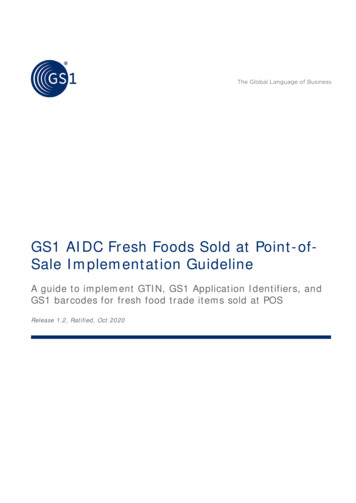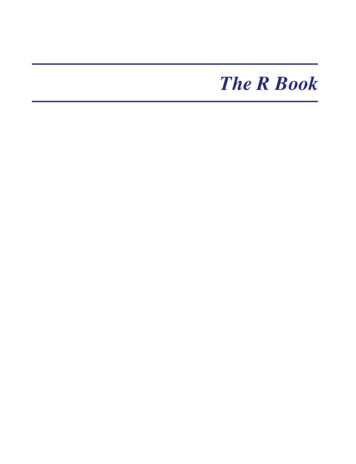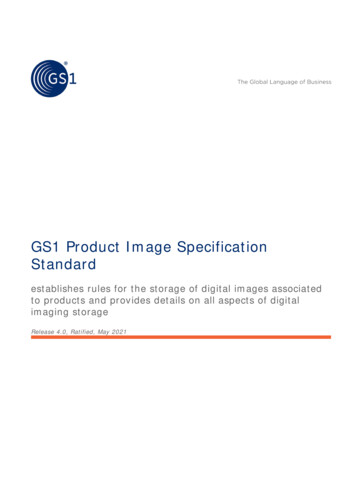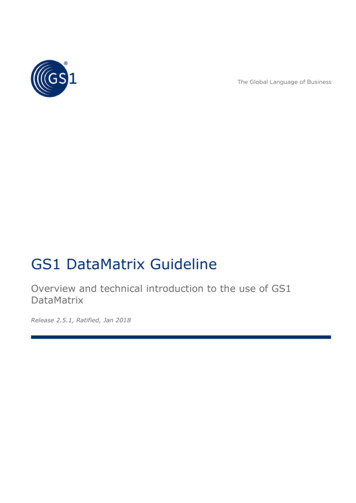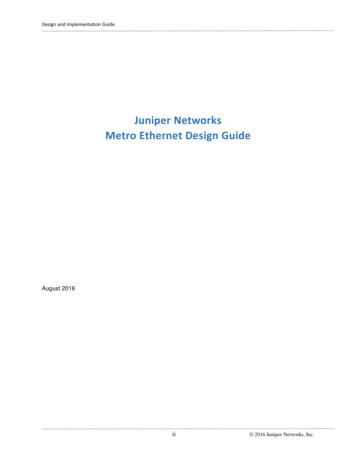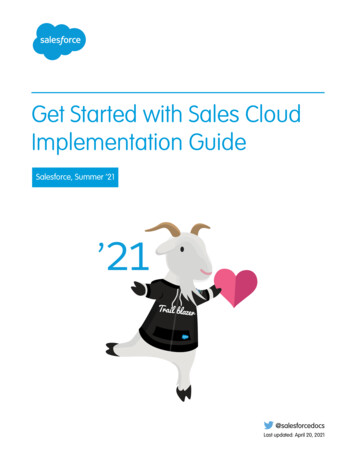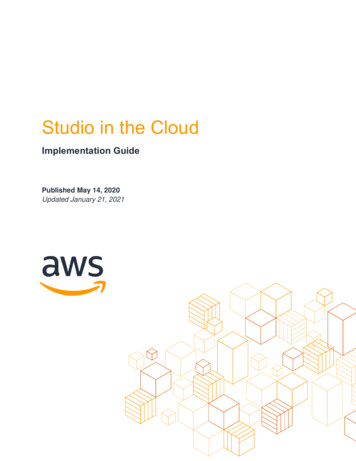
Transcription
UPC Implementation Guide:How to Develop and Maintaina Top Quality UPCPublished by the Uniform Code Council, Inc.December 1991885 Don Mills Road, Suite 222Toronto, Ontario M3C 1V9Tel: 416-510-8039 1-800-567-7084Fax: 416-510-8043 email: info@eccnet.org
UPC Implementation Guide:How to Develop and Maintaina Top Quality UPCCopyright (c) 1991 Uniform Code Council, Inc. All rights reserved. December, 1991*In this publication, the letters "UPC." are used solely as an abbreviation for the "Universal ProductCode" which is a product identification system. They do not refer to the UPC , which is a federallyregistered certification mark of the International Association of Plumbing and Mechanical Officials("IAPMO") to certify compliance with the Uniform Plumbing Code as authorized by IAPMO.TABLE OF CONTENTSIntroduction:Chapter I:"So You're New to UPC"Chapter II:"UPC Quality"Chapter III:"For Retailers Only"Chapter IV:"About Those Other UPC Applications"Chapter V:"The Code For Shipping Containers"Appendix A:Glossary of Commonly Used TermsAppendix B:How To .Appendix C:UPC Quality ChecklistBibliographyAcknowledgements
Introduction Who Is This Book Written For?Why Should I Read This Book?What Are the Goals Of This Book?Why Do I Need The UCC Technical Manuals?What Are The Uniform Code Council and The ElectronicCommerce Council of Canada?The Universal Product Code (UPC) serves as the cornerstone of a globalnew age in retailing. The code has been in place since the early 1970sallowing suppliers and distributors of consumer products around the worldto build upon the UPC as they continue to change the fundamental waysof running their businesses. The UPC is now a critical part of the entireproduct cycle - from manufacturer through distributor to consumer.The full UPC system includes numbers - for people to read - and barcodes - for machines to read. Both the numbers and the bar code areprinted on a consumer package with each unique package showing itsown unique number and bar code.The Uniform Code Council administers the assignment of all UPCmanufacturer identification numbers to preserve the uniqueness of eachindividual item. The full UPC system is intended to provide readers of thecode - both people and machines - with a reliable way to make businesseswork more effectively through accurate product identification.Who Is This Book Written For?This book has been written for two experience levels of UPC users:The first time user can learn what it takes to put a top quality UPCbar code on a consumer product The experienced user can quickly find answers to specificquestions If you are a first time user, you should read the entire introduction and allof Chapters I and II. Read each remaining chapter in its entirety if it coversany subject of interest to you.If you are an experienced user, you should at least read Chapter IIconcerning UPC quality completely. Then go to the Table of Contents tofind where your questions are answered in the other chapters.
The Appendices contain a wealth of information that can be important toyou now or at a later time. You should become familiar with their contentsso that you can refer to them as needed.Why Should I Read This Book?Suppliers and distributors of consumer products enjoy great benefits fromusing top quality UPCs. Attesting to the importance of UPC quality, seniorindustry executives assert:The Universal Product Code.is the foundation oftechnological systems which make the U.S. retail system theenvy of the world. Yet, its contribution to cost savings forsuppliers, distributors, and consumers hinges totally on thesimple quality of the printed symbol itself. Unscannablesymbols increase costs rather than reduce them, and theyerode consumer confidence in the entire electronic systemwhich is key to efficient retail operations. First priority for allUPC users must be the quality, integrity, and first-scancapability of the symbol itself.Byron Felter President, J.B. Felter AffiliatesMember of the UCC Board of Governors"There is a win-win situation for both retailers andmanufacturers when accurate data is captured at thecheckstand. Improved symbol quality can enhance datasubstantially. We urge all companies involved with printingsymbols to make sure that they meticulously follow theguidelines for symbol quality. We will all benefit."Byron AllumbaughChairman of the BoardChief Executive OfficerRalphs Grocery CompanyMember of the UCC Board of GovernorsIn summary, both manufacturers and retailers are increasingly benefitingfrom information systems that use UPCs to: Gather accurate point-of-sale data
Increase store checkout productivity and simplify front-endoperations Improve merchandising decisions such as shelf space allocation Improve marketing decisions such as promotion evaluation Reduce operating costs such as excessive inventroy levels To deliver the benefits - and to help give consumers what they want whenthey want it-the UPC must be easily readable and contain the correctinformation. If it fails to meet either requirement, the system reading thebar code simply will not work. For example, a "bad" UPC could cause thewrong price to be charged at the checkout resulting in consumer mistrust.Any company involved with producing, distributing or selling consumerpackage goods can benefit from UPC-based technology. But it must alsoprevent "bad" UPCs. Manufacturers, graphic designers, film mastersuppliers, printers of packages, wholesalers and retailers all share in theoverall responsibility for making the UPC system work. This book is writtenfor each of these audiences - it is written for you - so that you can benefitfrom the new age of UPC-based technology.What Are The Goals Of This Book?The ultimate goal of this book is to improve the first pass read rate ofUPCs in the entire consumer product industry. By that measure, you willknow whether UPC-related benefits are increasing within your owncompany. The UPC Implementation Guide is a top level introduction to theUniversal Product Code with three immediate goals. These goals are to:1. Explain important UPC issues in a non-technical fashion.2. Help you implement, maintain, and use the highest quality UPCs.3. Refer you to existing Uniform Code Council technical manuals andother published resources for specific technical information.This book is not intended to replace existing UCC publications. Rather it ismeant to complement them by serving as a starting point for you as youdo your part to ensure the scannability of UPCs.Why Do I Need The UCC Technical Manuals?If you need more technical information about the UPC system, you shouldrefer to the technical manuals published by the Uniform Code Council.
These manuals contain all the specific information needed to implementand use the Universal Product Code. A summary of the UCC technicalmanuals is as follows: UPC Guidelines Manual - Provides information for implementingthe UPC numbering system including how to assign UPCs andprocedures for use of UPC.UPC Symbol Specification Manual - Contains detailed technicalinformation about how to translate a UPC number into its machinereadable bar code and how to properly print a UPC.UPC Symbol Location Guidelines Manual - Identifies the properlocation for UPCs on consumer packages.UPC Film Master Verification Manual - Serves as a supplementto the UPC Symbol Specification Manual and the UPC SymbolLocation Guidelines Manual. It also contains procedures forverifying film master accuracy.UPC Coupon Code Guidelines Manual - Describes how to applythe UPC to manufacturer and store coupons.Application Standards for Shipping Container Codes Describes how to identify each shipping container of a product witha special number and a machine-readable bar code.UCC/EAN-128 Application Identifier. - Extends the existing UCCand EAN item and shipping container bar code standards to includeadditional information about products and shipments.UPC Marking Guidelines for General Merchandise and Apparel- Describes how to properly use the WC on branded apparel andgeneral merchandise including proper tag and label location,format, and contentUPC Data Communications Guidelines for GeneralMerchandise and Apparel - Facilitates the introduction of the UPCinto product identification systems in the general merchandiseindustryUPC Industrial and Commercial Guidelines Manual - Provides abroad overview of how to implement UPCs for industrial andcommercial productsWhat are the Uniform Code Council and theElectronic Commerce Council of Canada?The Uniform Code Council (UCC) and the Electronic CommerceCouncil of Canada (ECCC) are not for profit administrative andeducational organizations that:
Work with U.S. and Canadian industry to develop andadminister product identification and electronic data interchange(EDI) standards. Issue a UPC identification number to the owner/controller of aproduct label, i.e., a manufacturer, retailer, wholesaler, jobber,etc. Publish all UPC technical specifications and guidelines. Educate the business community about the Universal ProductCode
Chapter I: "So You're New to UPC"If you would like to learn the basics of the Universal Product Code, thischapter is meant for you. This chapter answers the following questions: What is the UPC?What is the UPC Number?What is the UPC Bar Code?How Do I Apply the UPC to a Product?Steps For Developing a Quality UPCWhen Should I Change the UPC?How Do I Print the UPC?Key Factors for Determining Print MethodWhat is the UPC?The UPC consists of two parts - the machine-readable bar code and thehuman-readable UPC number.Universal Product CodeUPCs are frequently incorporated into the package graphics. When thisdirect printing is not feasible, UPCs are applied to products with tags oradhesive labels.Tags containing UPCs are often attached to products such as apparelitems. UPCs printed on adhesive labels are used on random weightproducts - produce, meat, deli items - and other consumer products whenit is impractical to print a UPC directly on the package.
What is the UPC Number?The Universal Product Code number is the unique 12 digit identification ofan individual consumer product.Structure of the Universal Product Code NumberThe entire UPC number includes a six digit manufacturer numberassigned by the Uniform Code Council. The first of these six digits isreferred to as the number system character. This six digit field is followedby a five digit item number assigned by the owner/controller of the productlabel. The 12th and final digit is a check character.Manufacturer Identification NumberThe manufacturer identification number is a six digit number assigned bythe UCC. One unique manufacturer identification number is assigned toeach member company of the UCC.
The first digit is called the number system character. Number systemcharacters "0" through "9" indicate the following categories:Number SystemCharacterRetail Category or Function0, 6, 72Regular UPC codes.Random weight items, such as meat and produce,symbol-marked at store level.National Drug Code and National Health RelatedItems Code. Note that the symbol is not affected bythe various internal structures possible with the NDCor HRI codes.For use without code format restriction and with checkdigit protection for in-store marking by retailers.For use on coupons.Reserved for uses unidentified at this time.3451, 8, 9For more information on the Number System Character, see Chapter IV ofthis document or the UPC Symbol Specification Manual.Item NumberThe item number is a five digit number assigned and controlled by themanufacturer. A manufacturer may assign any five digits to any item itproduces as long as each individual product - one stock-keeping unit receives its own unique item number.The Uniform Code Council recommends against any meaning or structurebeing applied to any portion of the item number. An unstructured approachpermits the maximum of 100.000 item numbers per manufactureridentification number.Check CharacterThe final digit is the single digit check character. It is used to verify theaccuracy of the entire UPC number. For example, if a cashier key enters aUPC, the system performs a calculation on the numbers entered andcompares the result to the check character to tell the computer that the
entire UPC has been entered correctly. When a UPC is scanned, thecheck character also helps the scanning system verify that it has correctlyread the bar code. See Appendix B for an example of how to calculate thecheck character.What is the UPC Bar Code?The UPC bar code is the machine-readable representation of theUniversal Product Code number - the bars and spaces.The important characteristics of the UPC that determine its scannabilityare its quiet zone, size, contrast between the dark bars and light spaces,and the pattern of varying widths of these bars and spaces.Quiet Zone - UPCs have an area to the left and right of the bar code thatis free of all printing. This quiet zone is necessary because in order to reada UPC, the scanner measures the dark bars and light spaces at a veryrapid speed. The quiet zone alerts and prepares the scanner for the barcode that follows. Since UPCs can be scanned from either direction-left toright or right to left - quiet zones are required at both ends.Size - The Version A UPC - including numbers, bar code, and quiet zone covers 1.4984 square inches and is 1.469 inches wide by 1.02 inches highat nominal (100%) size. Some UPCs may be larger or smaller than thisstandard depending on package design and printing conditions. ( SeeChapter II. ) In general, larger UPCs scan better than smaller ones. Theminimum size is 1.175 by .816 inches (see Appendix B for the full range ofUPC sizes ).
UPC Version E (zero-suppressed) has very limited application forsmall packages which will not support the Version A symbol. Thisversion, however, is available only under number system character"on. Appendix B il
The Universal Product Code number is the unique 12 digit identification of an individual consumer product. Structure of the Universal Product Code Number The entire UPC number includes a six digit manufacturer number assigned by the Uniform Code Council. The first of these six digits is referred to as the number system character. This six digit field is followed
